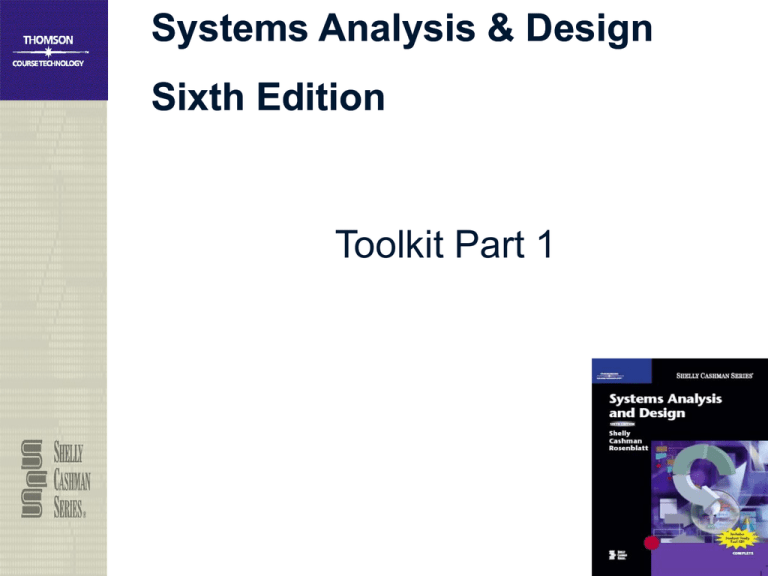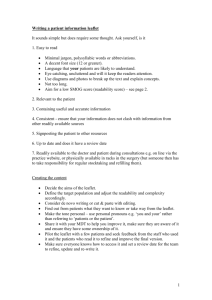Toolkit 1 Study Tool
advertisement

Systems Analysis & Design Sixth Edition Toolkit Part 1 Toolkit Objectives ● List the guidelines for successful communications ● Explain the importance of effective letters, memos, and e-mail communication ● Explain how to measure the readability of written material ● Describe the organization of written reports that are required during the SDLC and explain each report section 2 Toolkit Objectives ● List the guidelines for effective oral communication ● Organize and plan an oral presentation ● Use speaking techniques to achieve your objectives 3 Introduction ● A successful systems analyst must have good written and oral communication skills to perform his or her job effectively ● Never underestimate the importance of effective communications 4 Successful Communication Strategies ● Why, Who, What, When, and How – Why • – Who • – Know why you are communicating, and what you want to accomplish Know who your targets are What • Know what is expected of you and when to go into details 5 Successful Communication Strategies ● Why, Who, What, When, and How – When • Know when to speak and when to remain silent and let others continue the discussion – How • Know how to communicate effectively 6 Successful Communication Strategies ● Cultural Context – Communication strategy is affected by the cultural context in which the communication takes place – Cultural differences can relate to many factors – Corporate culture 7 Successful Communication Strategies ● Know Your Subject – – You must know your subject inside and out It is better to say, “I don’t know, but I’ll find out and get back to you,” rather than to guess 8 Written Communications ● Writing Style and Readability – – If you have not taken a writing course, you should consider doing so Suggestions: 1. Know your audience 2. Use active voice whenever possible – passive voice rarely 3. Keep your writing concise and well-organized 9 Written Communications ● Writing Style and Readability – Suggestions: 4. 5. 6. 7. 8. 9. 10. Use an appropriate style Use lists Use short, easy-to-understand words Avoid repeating the same word too often Check your spelling – spell checker Check your grammar – grammar checker Review your work carefully 10 Written Communications ● Writing Style and Readability – – – Readability Flesch Reading Ease score Flesch-Kincaid Grade Level score 11 Written Communications ● E-Mail, Memos, and Letters – E-mail is the primary form of communication in most companies – Many companies use workgroup software – In-house memos still are important, and external communications often require letters printed on company letterhead 12 Written Communications ● E-Mail, Memos, and Letters – Template – E-mail 13 Written Communications ● Reports – You must prepare many reports during the systems development life cycle – In some cases, you must present reports more formally – Cover memo – Introduction 14 Written Communications ● Reports – – – – – – Table of contents Executive summary Findings section Recommendations section Alternatives section Appendix 15 Oral Communications ● Oral presentation ● Define the Audience – Before you develop a detailed plan for a management presentation, you must define the audience 16 Oral Communications ● Define the Objectives – Your goals are the following: • Inform management of the status of the current system • Describe your findings concerning the current system problems • Explain the alternative solutions that you developed • Provide detailed cost and time estimates for the alternative solutions • Recommend the best alternative and explain the reasons for your selection 17 Oral Communications ● Organize the Presentation – Plan your presentation in three stages: the introduction, the information, and the summary – You should be as specific as possible when presenting facts – In your summary, briefly review the main points, and then ask for questions 18 Oral Communications ● Define Any Technical Terms – Avoid specialized or technical terms whenever possible ● Prepare Presentation Aids – You should use helpful, appropriate visual aids to help the audience follow the logic of your presentation and hold their attention – Visual aids 19 Oral Communications ● Prepare Presentation Aids – Presentation software – Some overall guidelines include the following: • Prepare an overall outline that will be the foundation of your presentation • 7 by 7 rule • 6 by 6 rule 20 Oral Communications ● Practice – The most important part of your preparation is practice – You should rehearse several times – Do not be tempted to write a script – You will be able to establish a good rapport with your audience 21 Oral Communications ● The Presentation – Sell yourself and your credibility – Control the presentation – Answer questions appropriately 22 Oral Communications ● The Presentation – Use effective speaking techniques 1. 2. 3. 4. Control your environment Turn your nervousness to your advantage Avoid meaningless filler words and phrases Practice! Practice! Practice! 23 Toolkit Summary ● Your success as a systems analyst depends on your ability to communicate effectively ● You will be judged by your written work, so it must be free of grammatical, spelling, and punctuation errors ● In addition to written communications, you must communicate effectively in person 24 Toolkit Summary ● When you develop slide presentations, you should follow the 6 by 6 rule or 7 by 7 rule and other guidelines ● When you give the presentation, you are selling your ideas and your credibility ● Toolkit Part 1 complete 25

![Service Coordination Toolkit Transition Planning Checklist [ DOC ]](http://s3.studylib.net/store/data/006933472_1-c85cecf2cfb8d9a7f8ddf8ceba8acaf8-300x300.png)


